
by John P. Pratt
11 Jan 2020, 1 Witness (P), Trees (PH), End Tabernacles (UE)
©2020 by John P. Pratt. All rights Reserved.
|
1. Snowman Seven Pattern 1.1 Pattern of Seven 1.2 Jubilee Calendar 1.3 Snowman Constellations 1.4 Seven Angels 2. Three Priesthoods 2.1 Aaronic 2.2 Melchizedek 2.3 Patriarchal 2.4 Eternal Round Steps 3. Peter, James, & John 4. Priesthood Restorers 5. Conclusion Notes |
The various levels of priesthood have not been well understood other than that there are three grand divisions. Sometimes priesthood levels have been confused with church offices. Now it has been discovered that a well known pattern which divides seven elements into three parts also distinguishes and orders seven levels of priesthood. Because the three parts contain one, two, and four elements, differing in size like the usual three parts of a snowman, the pattern is here named the "Snowman Seven".
 |
Before considering the Snowman Seven pattern to group priesthood levels, let us review the priesthood Pattern of Seven used for ordering their assignments, as discussed in an earlier article.[1]
 |
On the other hand, there is one unique quorum which has not had well defined responsibilities given in the standard scriptures. It is the Quorum of Seventy, which has up to seventy members, and has seven presidents. Not only are their jobs not defined, it seems upside down because the seventh president is the chief executive (D&C 107:93-94)!
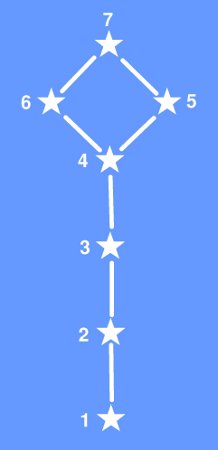 |
Figure 1 shows how the two linked presidencies are arranged in the priesthood Pattern of Seven. Note that the bottom presidency is upside down because of the shared secretary. That means the entire pattern could also be inverted if it were desired to have the more important president (number 7) on top.
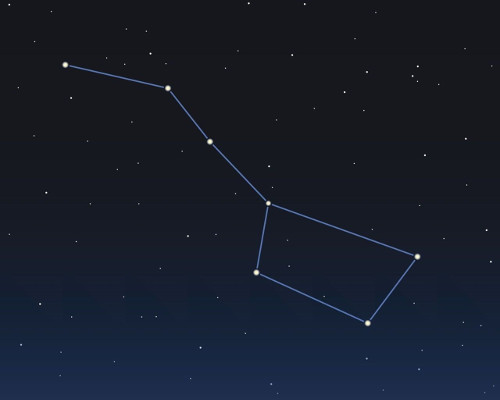 |
 |
To introduce the pattern let us look at one use of it in sacred calendars. The Jubilee Calendar divides the year into seven equal seasons, but it also divides it into three unequal sections by three festival weeks shown in red (see Figure 3). Those sections consist of 4 of the 7 seasons, then 2 of the 7, and finally the the last of the 7 seasons. Moreover, there is an increase in the importance of the sections. The first section with four seasons is the longest and forms a foundation of planting, watering, nourishing and tending the crop. The second section with two seasons is more important because it is the harvesting of the grain and wine. Harvesting is better than planting, although both are necessary. After all, it is the harvesting which was the purpose of all of the previous work. Finally comes the harvest of the olive oil, which is the most precious crop, and hence is the most important part of the year.
Note that this pattern is also used for the 7,000 years of history of Adam and Eve's family. The first 4,000 years were the Old Testament times. Then came the Meridian of Time when the Savior came for the Mid-Year Feast (like Hebrew Passover). Then came 2,000 years of the New Testament period where Jesus referred to his first servants as workers in the fields harvesting grain, whereas in the latter days He referred to them as workers in his vineyard. Then comes the next section dividing period, which we are now in, where the fields are burned in preparation for next year's crops. After the burning of the earth, the final 1,000 years is called the Millennium for a more spiritual people (represented by olive oil), which is the best of all. After the Millennium there is another little season. The main point here is that seven items are divided into three parts in a 4-2-1 division pattern.
This pattern of decreasing size is reminiscent of the archetypal snowman, shown in the first illustration in this article (for readers in tropical climates).
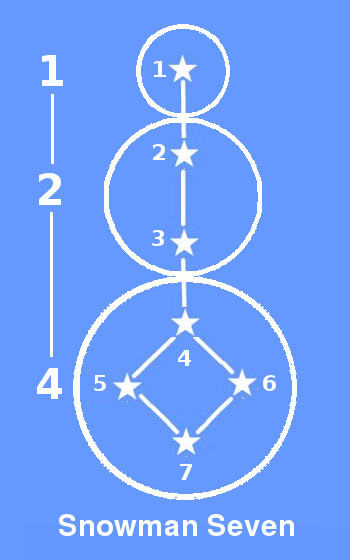 |
Figure 4 shows the basic idea by taking exactly the same stars as in the Pattern of Seven and drawing circles around them which magically changes it into a snowman! It is important to understand that the three parts are significant because what the stars represent corresponds to three different things.
Consider the case of the Big Dipper, which comprises the seven most prominent stars of the constellation of the Big Bear (Ursa Major). The part with four stars form the dipper which is rather different from the handle. In the manufacturing process, the bowl of a dipper is usually made separately from the handle. The same is true of a kite and its tail.
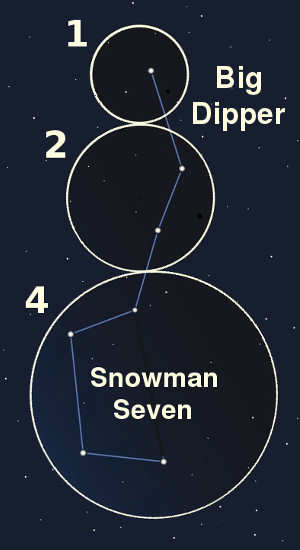 |
Now let us apply the Snowman Seven pattern to the seven chief angels. The Book of Enoch makes it clear that the lower four angels form a group which are sometimes called the "four royal stars".[3] They are four angels numbered 4 to 7, who are Raphael, Phanuel, Gabriel, and Michael. Those four have been identified as having lived as the mortals Enoch, Joseph Smith, Noah, and Adam, respectively. That is the reverse order of their importance or rank, with Michael being the archangel. The point here, however, is that in some sense those four are a unit. They are the big ball at the base of the snowman, which supports the others.
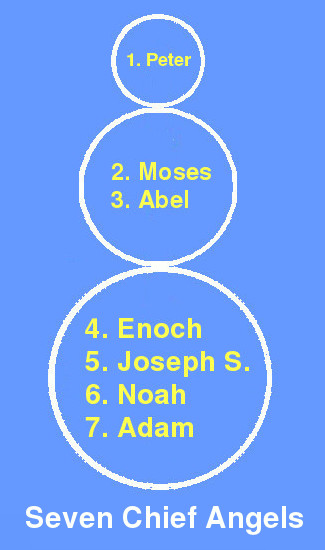 |
Joseph the Seer taught that there are three great priesthood divisions:
There are three grand orders of priesthood -- TPJS p. 322.
He goes to enumerate them as (1) Melchizedek, (2) Patriarchal, and (3) Aaronic. He admits that very little is known about the Patriarchal, but adds, "Go to and finish the [Nauvoo] temple and God will fill it with power, and you will receive more knowledge concerning this priesthood" (TPJS p. 323).
He does not state the order of importance of these priesthoods, but the Pattern of Seven indicates that the Patriarchal priesthood is actually the highest priesthood because the group is headed by Adam, the chief president of them all. Another clue that the Patriarch is the highest is that originally when sustaining the general authorities of the Church, the patriarch's name was read first, followed by the first presidency (D&C 124:123-128). Let us now consider each of these priesthoods.
The Aaronic Priesthood is named after Aaron, the brother of Moses. The priests of the Jewish Temple all had to be literal descendants of Aaron; they were the "sons of Aaron". In these latter days, all those who have this priesthood conferred upon them become the sons of Aaron by adoption (D&C 84:33-34).
In the restored Church there are three church offices which require having had the Aaronic Priesthood conferred: (1) priest, (2) teacher, and (3) deacon. These perform outward ordinances such as administering the sacrament and baptism.
Baptism is required to inherit the Kingdom of God (3 Nephi 11:38). Thus, someone holding the keys to the Kingdom of Heaven, such as Peter was told that he would be given (Mat. 16:18-19), might hold the keys of the Aaronic Priesthood. After all, the priesthood key to that ordinance is the only one required to enter the Kingdom of God! When John the Baptist restored the Aaronic Priesthood of Joseph and Oliver, he stated that he was doing so under by the direction of Peter, James, and John (D&C 13 heading).
The higher priesthood is called by the Lord the Melchizedek priesthood. It has not been well understood by Church members that it has two sublevels, even though there are indications in the scriptures. Church leaders, including Joseph Smith, did not use separate names for these two levels of priesthood, but just lumped them together as "Melchizedek Priesthood". To distinguish them from each other, in my work they have been called the Apostlic Priesthood and the Melchizedek Priesthood.
As far as Church offices go, the Apostolic Priesthood is required to be an elder, seventy, or apostle. That is probably why apostles are called by the title "Elder". It was explicitly stated in the LDS general conference on Sat 31 Mar 2018 that "An elder holds as much priesthood as an Apostle", giving D&C 20:38 as a reference.[4]
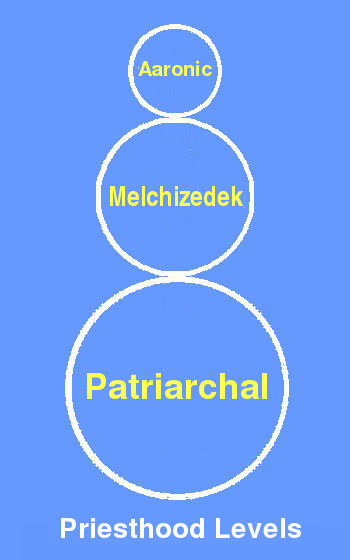 |
As this article was being prepared, it was realized that the Lord has already given us a name for what has been called the Apostolic Priesthood in my articles. It now appears that it should be called the "Mosaic Priesthood" after Moses, even as the Aaronic Priesthood is called after his brother. Here is where the Lord explained it:
For whoso is faithful unto the obtaining these two priesthoods of which I have spoken, and the magnifying their calling, are sanctified by the Spirit unto the renewing of their bodies. They become the sons of Moses and of Aaron and the seed of Abraham, and the church and kingdom, and the elect of God. -- D&C 84:33-34
That is, all those with the higher priesthood, even the lower part of it, become the sons of Moses even as those with the lower priesthood become sons of Aaron. It is not much of a leap to deduce that if we call the latter priesthood "Aaronic", then the former should probably be called "Mosaic". The word "Apostolic" was only used in my articles as a place holder until the true name was discovered. My future articles should refer to the priesthood of elders, seventies, and apostles as the "Mosaic Priesthood", reserving the title "Melchizedek" for high priests after the order of Melchizedek.
The Patriarchal Priesthood is that held by the patriarchs such Abraham, Isaac, and Jacob. Almost nothing has been known about this priesthood except that we are waiting for its fulness to be restored, perhaps when the right temple is completed as the Lord told Joseph the Seer. That fulness had been restored to Joseph and Oliver, but somehow it had been lost (D&C 124:28). The Lord stated that the fulness of the priesthood could only be restored in a temple, which is why they needed to complete the Nauvoo temple so that that could happen (D&C 124:31,34). Because it requires a temple in our day for the fulness to be bestowed, it seems clear that the occasion on which the fulness of the (Patriarchal) priesthood was restored occurred at the Kirtland Temple when the Savior, Moses, Elias, and Elijah appeared in sequence in vision and bestowed keys upon Joseph and Oliver, including the keys of turning the hearts of the children to their ancestral patriarchal fathers. At that time Elijah declared that all of the keys had been restored so that they should know that the coming of the Lord was at their doors:
After this vision closed, the heavens were again opened unto us; and Moses appeared before us, and committed unto us the keys of the gathering of Israel from the four parts of the earth, and the leading of the ten tribes from the land of the north. After this, Elias appeared, and committed the dispensation of the gospel of Abraham, saying that in us and our seed all generations after us should be blessed. After this vision had closed, another great and glorious vision burst upon us; for Elijah the prophet, who was taken to heaven without tasting death, stood before us, and said:
Behold, the time has fully come, which was spoken of by the mouth of Malachi--testifying that he [Elijah] should be sent, before the great and dreadful day of the Lord come--To turn the hearts of the fathers to the children, and the children to the fathers, lest the whole earth be smitten with a curse--Therefore, the keys of this dispensation are committed into your hands; and by this ye may know that the great and dreadful day of the Lord is near, even at the doors. -- D&C 110:11-16
The event which caused the fulness of the priesthood to be lost is not known to me, but it must have been between Sun 3 Apr 1836, when it apparently was conferred in the Kirtland temple, and Tue 19 Jan 1841, when the Lord commanded Joseph to build the Nauvoo Temple so that it could be restored again. It is also clear that the Melchizedek Priesthood had not been lost by that time, nor the lowest office in the Patriarchal Priesthood (Presiding Patriarch), because in that same revelation in 1841 the Lord provided the order in which Church officers should be presented in general conference. That order was the first (and highest) office to be presented was the Patriarch (with the Patriarchal Priesthood) followed by the First Presidency (with the Melchizedek Priesthood), followed by the Quorum of Twelve (Mosaic Priesthood) (D&C 124:123-128).
 |
Then the suggestion was made that each of the seven chief angels presided over souls who are on one of those steps. The concept is similar to have seven coaches, who are all top level players, coaching seven levels of players in a sport, such as those ages 8-12, 13-14, 15-16, etc. Then an attempt was made to correlate each of the seven angels to being the coach (presiding over) one of those levels.[6]
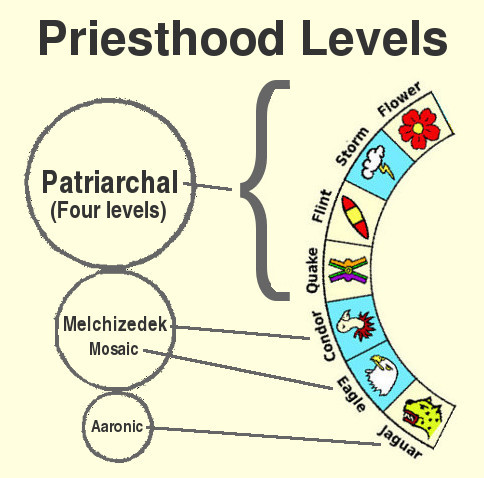 |
The Snowman Pattern appears to be the key. First, it should be noted that the pattern can be inverted (see Figure 7). Remember that the Pattern of Seven shows two priesthood presidencies with one inverted.
The reasons for relating these steps in the Eternal Round to priesthood levels are three fold: (1) the first step (Jaguar) is clearly related to the Aaronic priesthood. Then (2) the next two glyphs are both birds (Eagle and Condor), as if being a pair which could form the middle ball of a Snowman Seven pattern. Moreover, a big point is that the Thunderbird (Condor) flies higher that the Eagle and was chosen from the vulture family because it eats death for lunch (is greater than death). Finally, (3) after those two, there are four more steps which could easily be grouped together to form the last large ball of an inverted snowman. This is illustrated in Figure 8, where the names of priesthood levels within the Patriarchal group are not yet known. This is all still a work in progress.
As evidence for dividing the Patriarchal Priesthood into four levels, notice that three angels who conferred authority on Joseph and Oliver in the Kirtland temple each stated that what they restored had a family-oriented purpose: Moses with the keys to gather the family of Israel, Elias with the keys of dispensing the gospel of Father Abraham, and Elijah with the keys to turn patriarchal family hearts to each other and seal them into an eternal family. So those levels could all be in addition to and above the basic level of Patriarchal Priesthood.
Thus, it is here suggested that the last seven steps of the Eternal Round correspond to seven levels of priesthood, arranged in ascending order. Let us now consider how all of those priesthood levels were apparently restored to both Joseph Smith and Oliver Cowdery.
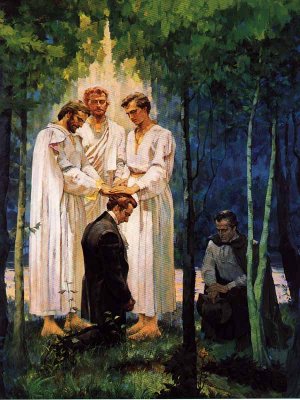 |
Peter undoubtedly holds higher priesthood than Aaronic because he was an apostle and also had power to seal on earth and in heaven. The concept is like the requirement that a ward bishop, who presides over those having the Aaronic Priesthood in a ward, is generally required to hold the Melchizedek Priesthood.
Shortly thereafter, before early June 1829 when they moved to the Peter Whitmer home, Peter, James, and John appeared to Joseph and Oliver and ordained them to be apostles of the Lord Jesus Christ (D&C 27:12). That gave them enough priesthood to perform confirmations at the organization of the Church of Christ. The offices to which they were ordained at the founding of the Church were that of first elder and second elder. The office of elder in the Church holds the same priesthood as does the office of apostle in the Church (D&C 20:38).
As suggested above, that level of priesthood has not had a known official name hitherto, but it is suggested herein that the level be called the Mosaic Priesthood. Who ordained Joseph and Oliver to that level of priesthood? In asking that question, another question is raised. Why was it necessary that all three of Peter, James, and John be present for the occasion?
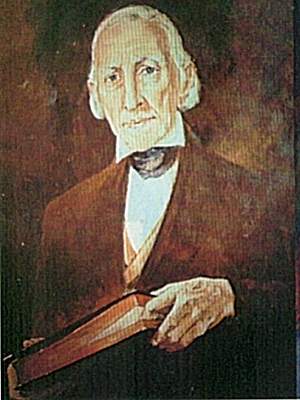 |
It is proposed that Peter conferred the Mosaic Priesthood, that James then conferred the Melchizedek Priesthood, and finally that John conferred the (lowest level of the) Patriarchal Priesthood on them. None of these are offices in a church, but rather levels of priesthood (fellowship with heavenly beings). After this, they were instructed not to ordain each other to any church office (elder) until the church was founded.
On Tue 6 Apr 1830 the Church of Christ was born. The order of events that day is important. The first order of business was to have a vote of those present who had been baptized to accept Joseph and Oliver as spiritual leaders, which vote was really the beginning of the Church. Then the sacrament was administered, being an Aaronic Priesthood ordinance. Then Joseph and Oliver ordained each other to be elders in the newly born Church. Now that they were elders who already held the Mosaic Priesthood, they were authorized to confirm those who had been baptized to be members of the Church and to receive the gift of the Holy Ghost.
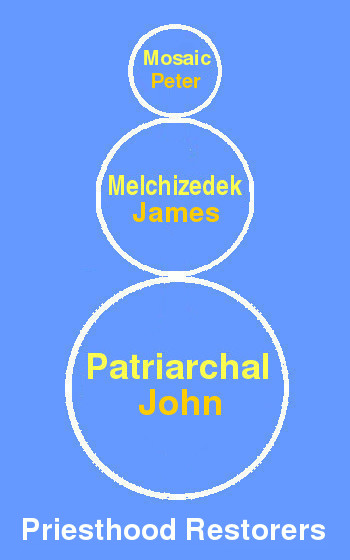 |
On Wed 18 Dec 1833, Joseph ordained his father Joseph Smith, Sr., to be the first Church Patriarch, which requires the higher Patriarchal Priesthood. He could do that because he had already received it from John four years earlier.
In Figure 9, the levels of priesthood are shown in the order restored and in the order of importance. Again, that is confirmed by the order in which the officers of the Church were presented in general conference: first, the highest office presented was the Patriarch (Patriarchal Priesthood) followed by the First Presidency (Melchizedek Priesthood), followed by the Quorum of Twelve (Mosaic Priesthood) (D&C 124:123-128).
Now some of these conclusions can be combined to produce another important list which provides supporting evidence for the proposals and conclusions made in this article. There is a record of seven angelic messengers appearing to both Joseph Smith and Oliver Cowdery who all bestowed priesthood and keys upon them. They are listed in Figure 10.
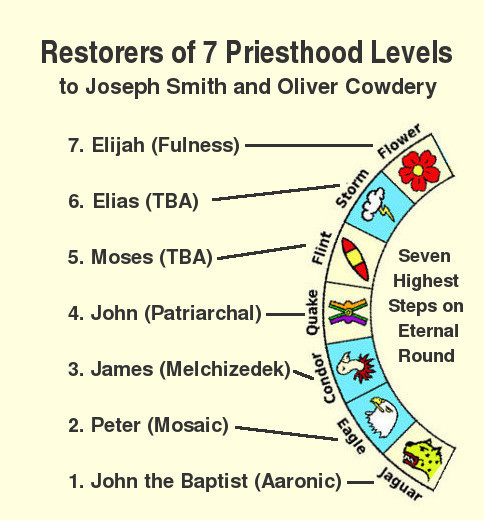 |
It appears that Joseph Smith used that name as a title to refer to a forerunner and applied it to John the Baptist, for example. For whatever reason, one of the 3 angels who appeared identified himself as Elias. Even as John the Baptist had the spirit of Elijah, it appears that we are to understand that Elias had the spirit of Gabriel, the angel who visited the father of John the Baptist (D&C 27:6-7). His name in mortality is not known to me at this time. Many have identified him with Noah, because he also had the spirit of Gabriel, but if it were indeed Noah, then it would be expected that he would have identified himself by that name. After all, Moses and Elijah used their mortal names. Accordingly, until it is understood why he may have been using a code name, he is not identified as Noah in this article.
Thus, there appears to be an excellent possible correlation between the seven proposed levels of priesthood and the last seven steps of the Eternal Round, which in turn may correlate to seven steps on the ladder to heaven which Jacob dreamed.
After the Pattern of Seven already proposed in an earlier article to describe the duties of the seven chief angels was reviewed, the "Snowman Seven" pattern was introduced to be correlated to seven levels of priesthood over which they preside.
The pattern divides seven items into three groups of varying size and importance, of four, two, and one item. That is the same as the seven seasons of the Jubilee year are divided by three festivals. The pattern is named for its resemblance to a snowman, in having three different-sized sections. It is noted that the same constellations which have been associated with the Pattern of Seven can also easily fit the Snowman Seven pattern. Because four of the seven angels are treated as a unit by the Book of Enoch and separate from the other three, those four also fit well into the base of the Snowman Seven.
The three known grand orders of priesthood of Patriarchal, Melchizedek, and Aaronic were also matched to the three parts of the Snowman Seven, suggesting that the Patriarchal Priesthood actually has four levels (in the lower ball) and the Melchizedek has two levels (in the middle ball). The proposed name for the lower of those two is the Mosaic Priesthood. Then these seven proposed priesthood levels were correlated to the last seven steps of the Eternal Round in an inverted Snowman Seven so that the Patriarchal Priesthood was on top.
It was then proposed that in their visit to Joseph and Oliver, Peter conferred on them the Mosaic Priesthood, James conferred the Melchizedek, and John conferred the Patriarchal (the lowest level thereof).
Finally, it was suggested that the three angels who bestowed priesthood keys to Joseph and Oliver in the Kirtland temple were actually conferring on them the three highest levels of the Patriarchal Priesthood, each with a family-oriented purpose: Moses with the gathering of the family of Israel, Elias with the gospel of Father Abraham, and Elijah turning hearts to ancient patriarchal fathers. That completed the restoration of all seven priesthood levels!
Thus, the patterns of calendars, constellations, and angelic visits all combine to testify of seven levels of priesthood which fall into three grand orders. All of these perfectly fitting puzzle pieces fit together to testify of the goodness and order of God!